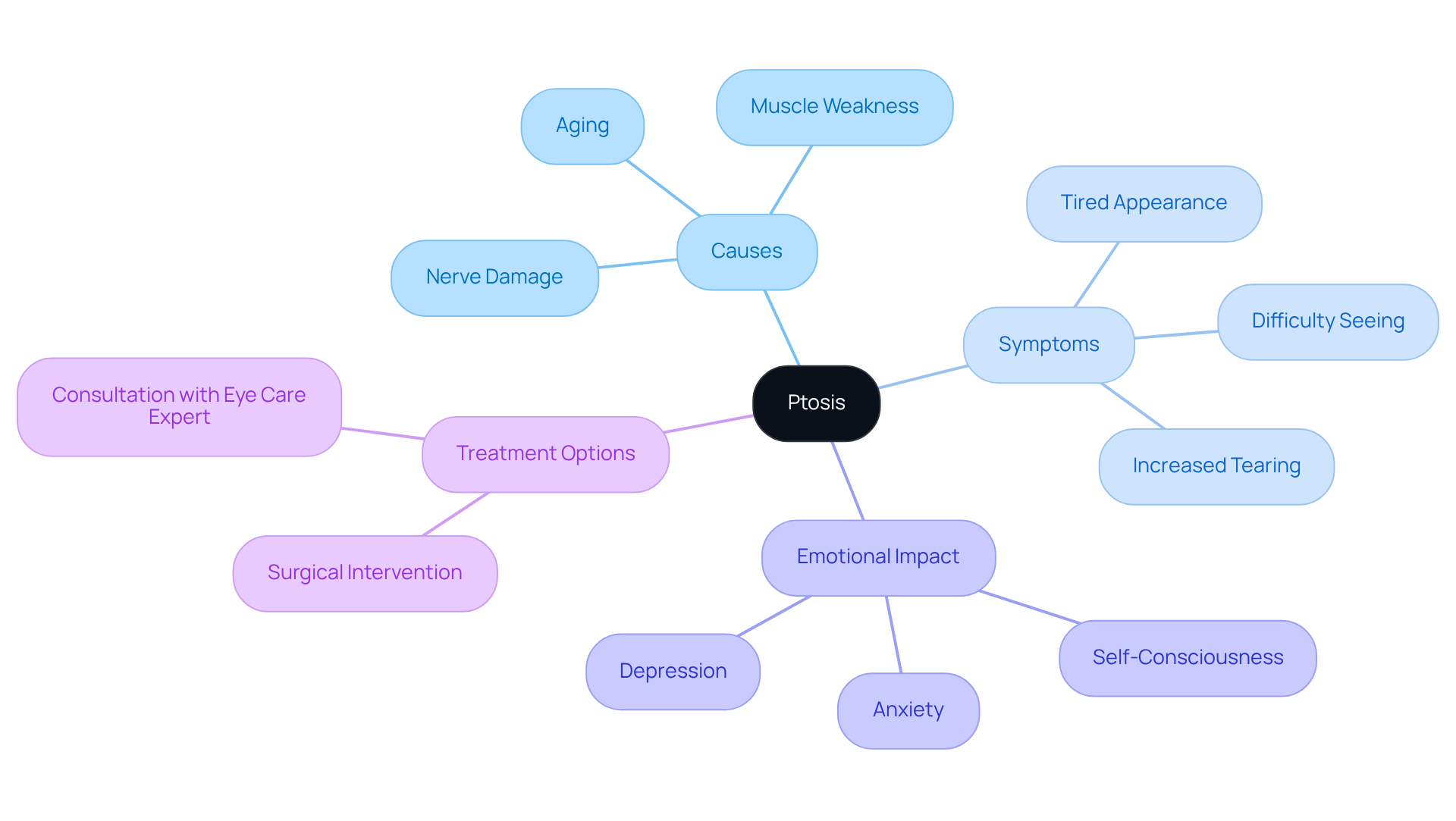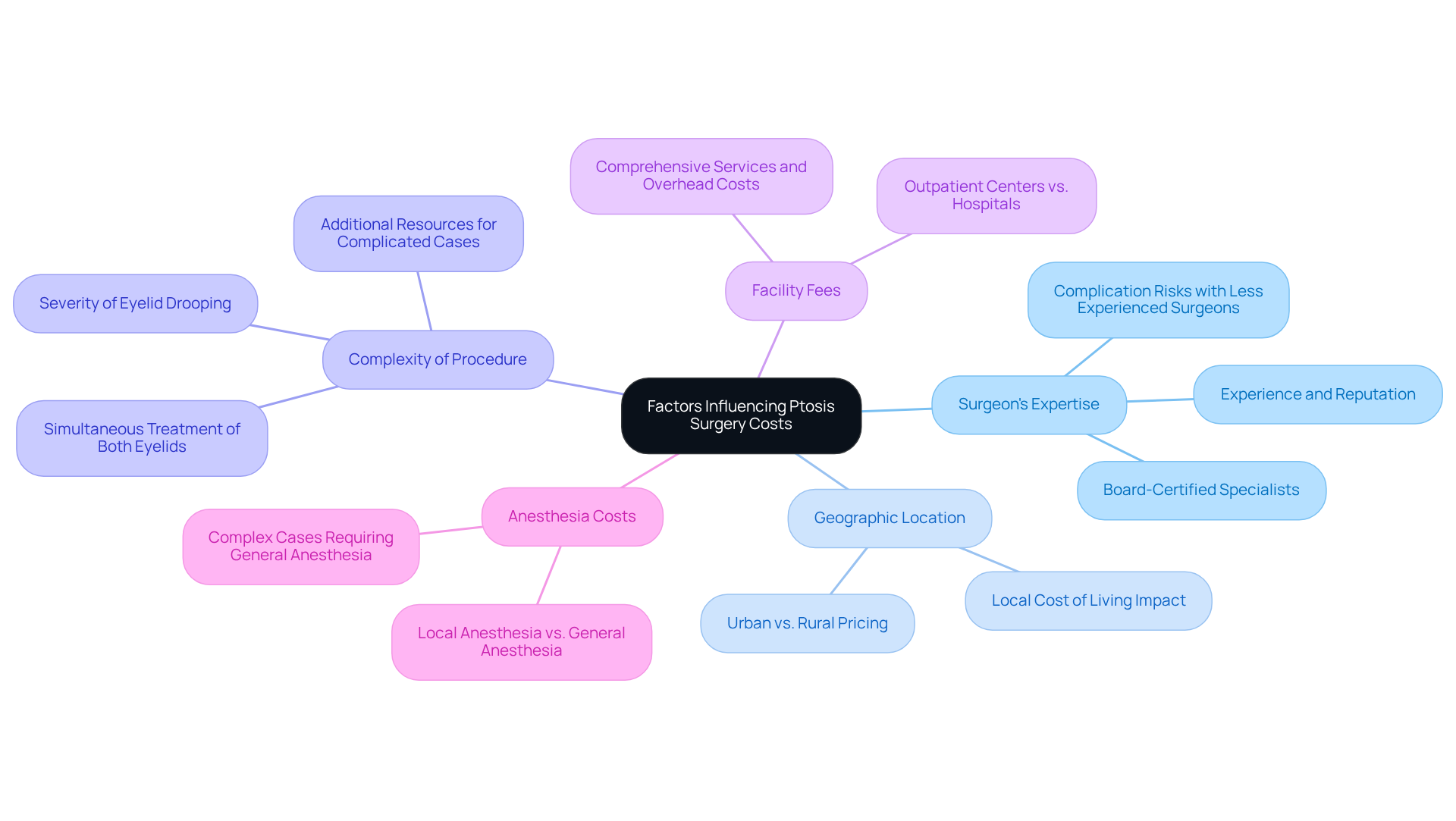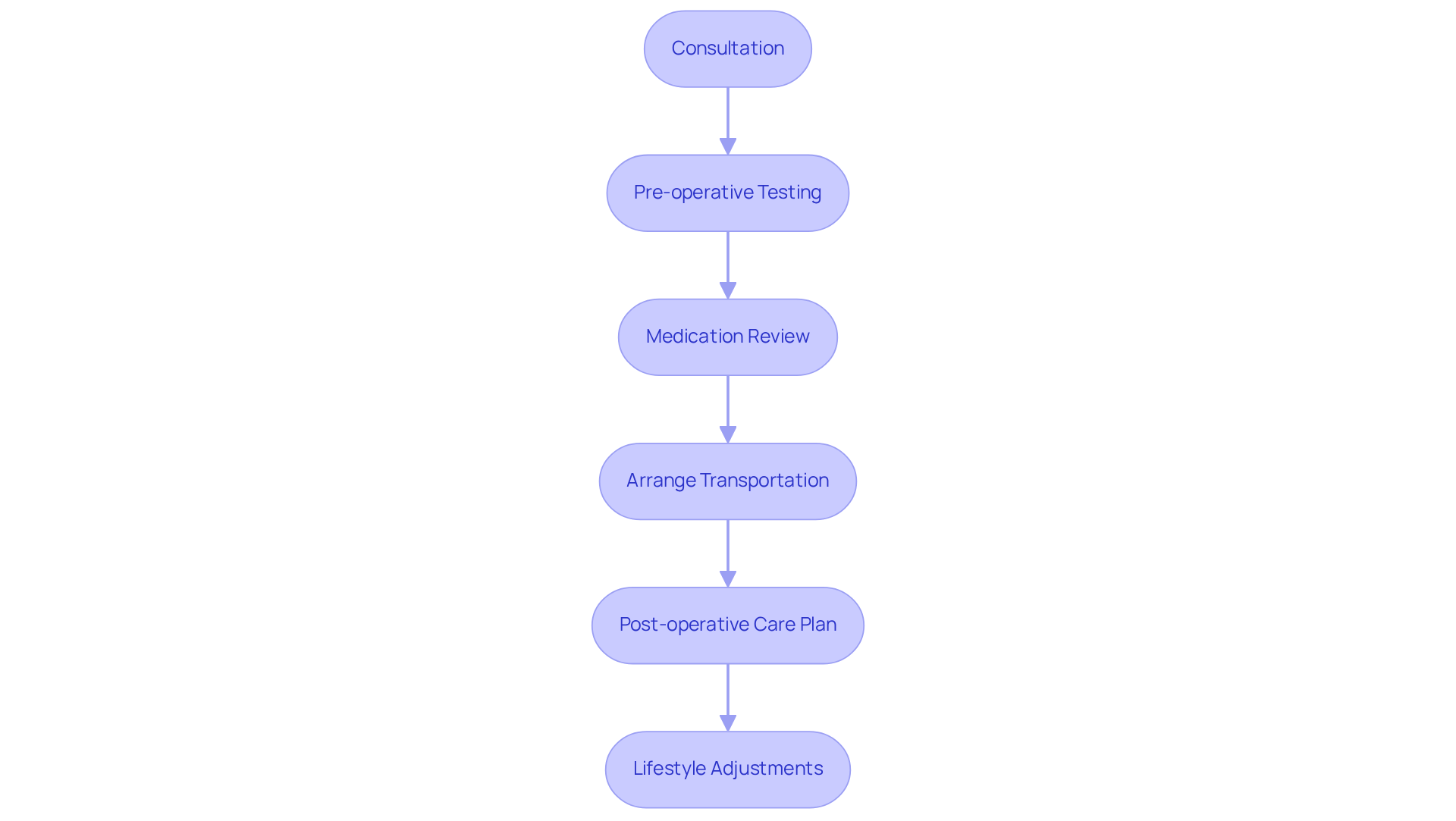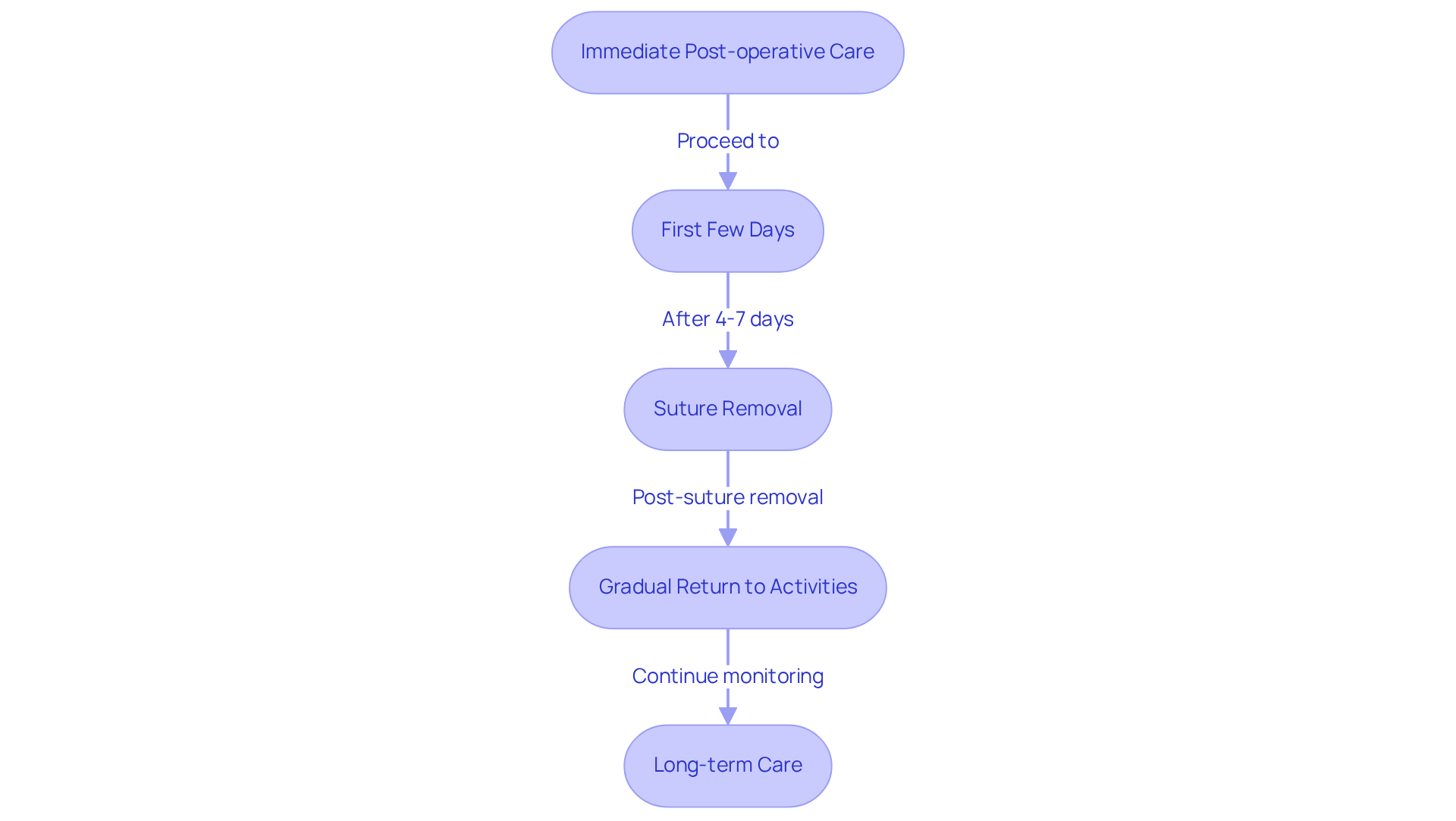Posted by: Northwest Eye in General on October 4, 2025
Overview
This article aims to help you understand the cost of ptosis surgery, including the important preparation and recovery steps involved. We recognize that this can be a concerning time, and it’s essential to consider various factors that influence the overall expenses. These include:
- The surgeon’s expertise
- Geographic location
- The complexity of the procedure
- Facility fees
- The type of anesthesia used
We understand that thorough preparation and attentive post-operative care are crucial for achieving a successful outcome. It’s common to feel overwhelmed, but rest assured that with the right support and information, you can navigate this process with confidence. We are here to help you through this journey, ensuring that you feel informed and cared for every step of the way.
Introduction
Understanding the intricacies of ptosis, commonly known as droopy eyelids, is essential for those facing this condition that can impact both vision and self-esteem. We understand that navigating the path toward surgical intervention can feel overwhelming. Patients often encounter a maze of costs influenced by factors such as:
- The surgeon’s expertise
- Geographic location
- The complexity of the procedure
However, with a clearer grasp of these elements, you can better prepare for the financial and emotional journey ahead. What steps can you take to ensure a smooth transition through the surgery and recovery process while managing the associated costs? We are here to help you through this process.
Define Ptosis: Understanding the Condition and Its Impact
Ptosis, often referred to as droopy eyelids, can be concerning as it causes the upper eyelid to sag over the eye, affecting one or both eyelids. This condition may arise from several factors, such as aging, muscle weakness, or nerve damage. Symptoms can lead to a tired appearance, difficulty seeing, and increased tearing, which might significantly impact daily life. We understand that this can be frustrating, as may make activities like reading or driving challenging, affecting your overall quality of life.
Many individuals also experience aesthetic concerns related to eyelid drooping. It’s common to feel self-conscious about one’s appearance, often describing themselves as looking ‘sleepy’ or having uneven eyelids. This perception can lead to heightened anxiety and feelings of depression regarding appearance. As one ophthalmologist noted, ‘Drooping of the eyelids may result in an aesthetically unpleasing look, impacting individuals’ self-esteem.’
Understanding eyelid droop is crucial because neglecting it can lead to complications such as amblyopia in children or further visual deterioration in adults. Fortunately, surgical intervention has shown promising results. Studies reveal that surgical management can significantly enhance both visual function and cosmetic appearance. For example, individuals with congenital eyelid drooping who underwent surgery achieved visual clarity between 6/6 and 6/18 afterward, demonstrating the effectiveness of these procedures.
If you notice signs of drooping eyelids or other ocular issues, we encourage you to consult with an eye care expert. A comprehensive assessment can help determine the seriousness of your condition and explore potential treatment options, including the ptosis surgery cost. Early intervention can lead to improved outcomes, enhancing both your vision and quality of life. Remember, we are here to help you through this process.

Identify Factors Influencing Ptosis Surgery Costs
Understanding ptosis surgery cost can be overwhelming, but we are here to help you navigate this process. Several key factors influence the expenses associated with this procedure:
- Surgeon’s Expertise: Your surgeon’s experience and reputation are crucial in determining the fee. Highly skilled surgeons often command higher prices due to their advanced techniques and proven successful outcomes. Choosing a board-certified plastic or oculoplastic specialist with significant expertise in eyelid procedures is vital. This is important because complications may arise with less experienced professionals.
- Geographic Location: It’s common to feel anxious about costs, and it’s worth noting that expenses can vary significantly based on your region and local cost of living. Urban centers typically have higher prices compared to rural areas, reflecting the increased demand and operational costs associated with metropolitan practices.
- Complexity of the Procedure: The severity of eyelid drooping, which can stem from conditions like thyroid eye disease or other lid issues, directly impacts the overall cost. More complicated cases may require additional resources, time, and specialized techniques, which can increase the price. Notably, over 90% of ptosis procedures require both sides to be addressed simultaneously, which can further affect expenses.
- Facility Fees: The type of establishment where your procedure is conducted also influences expenses. Surgeries performed in outpatient centers are generally less expensive than those in hospitals, which may charge higher fees due to their comprehensive services and overhead.
- Anesthesia Costs: It’s common to wonder about anesthesia fees. The type of anesthesia used can lead to additional costs, with local anesthesia typically being less expensive than general anesthesia, which may be necessary for more complex cases.
By understanding these elements, you can plan your finances more effectively for the procedure and explore funding alternatives if needed. For instance, opting for in-office procedures instead of hospital-based operations can save you 20-30% on expenses, making it a more cost-effective option for many.
On average, the ptosis surgery cost ranges from $4,500 to $9,000, and in severe cases, patients may qualify for insurance coverage. Additionally, most bruising and swelling usually clear up within 2-3 weeks, which is significant for you to consider when organizing your recovery.
We encourage you to check with your insurance providers regarding and to inquire about accepted plans to ensure you feel financially prepared for the procedure. Remember, we are here to support you through this journey.

Prepare for Ptosis Surgery: Essential Steps and Considerations
Preparing for ptosis surgery cost involves several essential steps that can significantly impact your outcome. We understand that this can be a daunting process, so here’s how to navigate it with confidence:
- Consultation: Schedule a comprehensive consultation with your ophthalmic surgeon. This is your opportunity to discuss your symptoms, medical history, and surgical options. It’s normal to have questions and concerns, and addressing these can greatly enhance your satisfaction. Studies show that 83.1% of patients who engage in thorough pre-operative consultations rate their outcomes positively after careful planning.
- Pre-operative Testing: Your surgeon may recommend specific tests to evaluate the severity of your ptosis. This assessment is vital for tailoring the procedure to your individual needs, ensuring the best possible approach.
- Medication Review: It’s important to inform your surgeon about all medications and supplements you are taking. Often, it’s necessary to stop specific blood thinners or anti-inflammatory medications at least one week prior to the procedure to reduce risks. This step is crucial for your safety.
- Arrange Transportation: Since you will be under anesthesia, arranging for someone to drive you home after the procedure is essential. This ensures your safety and comfort following surgery, allowing you to focus on your recovery.
- Post-operative Care Plan: Discuss your post-operative care strategy with your surgeon, including follow-up appointments and healing instructions. Understanding what to expect can ease anxiety and promote a .
- Lifestyle Adjustments: We encourage you to avoid smoking and alcohol consumption in the weeks leading up to surgery, as these can adversely affect healing. Embracing healthier habits can significantly improve your recovery.
- Prepare Your Home: Create a comfortable healing area at home with necessary supplies, such as cold compresses, medications, and easy-to-eat meals. A well-prepared environment can facilitate a more restful healing process.
By following these steps, you can help ensure a successful procedure while being mindful of the ptosis surgery cost and a smoother recovery process. Remember, we are here to help you through this journey, ultimately leading to improved eyelid function and aesthetics.

Manage Recovery After Ptosis Surgery: What to Expect
Recovery after ptosis surgery typically unfolds in several key stages:
- Immediate Post-operative Care: Following the procedure, we understand that you may feel anxious. Individuals are monitored briefly before discharge. Expect some swelling and bruising around the eyelids; this is a normal part of the healing process.
- First Few Days: It’s common to feel discomfort during this time. To alleviate swelling, apply for 10-15 minutes at a time. Resting with your head elevated can further minimize swelling. We advise avoiding strenuous activities and bending over for at least a week to promote healing.
- Suture Removal: Sutures are generally removed between 4 to 7 days post-surgery. Your surgeon will provide tailored instructions on caring for your eyelids during this period, ensuring proper healing.
- Gradual Return to Activities: Many individuals can resume light activities within a week, and after several days, you may find you can drive and move around without much difficulty. However, it’s advisable to refrain from heavy lifting and vigorous exercise for at least two weeks. Following your surgeon’s advice on when to resume normal activities is crucial for a smooth healing process.
- Long-term Care: Continue to monitor your eyelids for any unusual changes and attend all scheduled follow-up appointments. Complete healing can take about 3 months, during which you may observe gradual enhancements in eyelid appearance and function. It’s important to maintain hygiene and avoid irritants, such as makeup and contact lenses, for about two weeks post-surgery.
Surgeons emphasize that maintaining a good post-operative care regimen is vital for optimal healing. Dr. Elaine Chee observes, “Every healing journey is unique.” By remaining calm, adhering to your doctor’s guidance, and attending follow-up appointments, you can assist in securing the best result while considering the ptosis surgery cost. Following these guidelines can significantly enhance recovery outcomes, with 78.95% of patients reporting satisfaction with their results after surgery.

Conclusion
Understanding the complexities of ptosis surgery and its associated costs is essential for anyone considering this procedure. We understand that the journey to addressing droopy eyelids involves recognizing the impact of ptosis on daily life and navigating the financial landscape of surgical intervention. By gaining insight into the factors that influence ptosis surgery costs, individuals can make informed decisions that align with their health and aesthetic goals.
Key points discussed include:
- The importance of consulting with experienced surgeons
- The variability of costs based on geographic location and procedure complexity
- The necessity of thorough pre-operative preparation
Each of these elements plays a significant role in shaping the overall experience and outcome of ptosis surgery. It’s common to feel overwhelmed, but understanding the recovery process and following post-operative care guidelines can significantly enhance satisfaction and results.
Ultimately, addressing ptosis is not just about aesthetics; it is about improving quality of life and visual function. We encourage individuals to seek professional advice, explore financial assistance options, and prepare adequately for both the surgery and recovery. Taking these steps can lead to a transformative experience, enabling a clearer vision and renewed confidence. Remember, we are here to help you through this process.
Frequently Asked Questions
What is ptosis?
Ptosis, commonly known as droopy eyelids, is a condition where the upper eyelid sag over the eye, affecting one or both eyelids.
What causes ptosis?
Ptosis can arise from several factors, including aging, muscle weakness, or nerve damage.
What symptoms are associated with ptosis?
Symptoms of ptosis can include a tired appearance, difficulty seeing, and increased tearing, which may significantly impact daily life.
How does ptosis affect daily activities?
Obstructed vision from ptosis can make activities such as reading or driving challenging, ultimately affecting overall quality of life.
Are there aesthetic concerns related to ptosis?
Yes, individuals with ptosis often feel self-conscious about their appearance, describing themselves as looking ‘sleepy’ or having uneven eyelids, which can lead to anxiety and depression regarding their looks.
What are the potential complications of neglecting ptosis?
Neglecting ptosis can lead to complications such as amblyopia in children or further visual deterioration in adults.
What treatment options are available for ptosis?
Surgical intervention has shown promising results in treating ptosis, significantly enhancing both visual function and cosmetic appearance.
How effective is surgery for ptosis?
Studies indicate that individuals with congenital eyelid drooping who undergo surgery can achieve visual clarity between 6/6 and 6/18, demonstrating the effectiveness of these procedures.
When should I consult an eye care expert about ptosis?
If you notice signs of drooping eyelids or other ocular issues, it is advisable to consult with an eye care expert for a comprehensive assessment and to explore potential treatment options.
What should I consider regarding the cost of ptosis surgery?
It is important to discuss the ptosis surgery cost with your eye care expert as part of your consultation to understand the financial implications of treatment.






